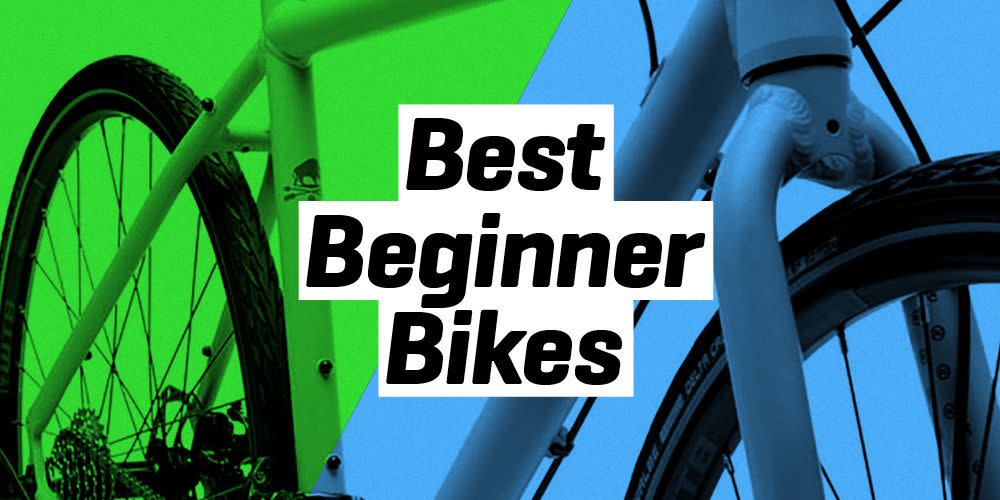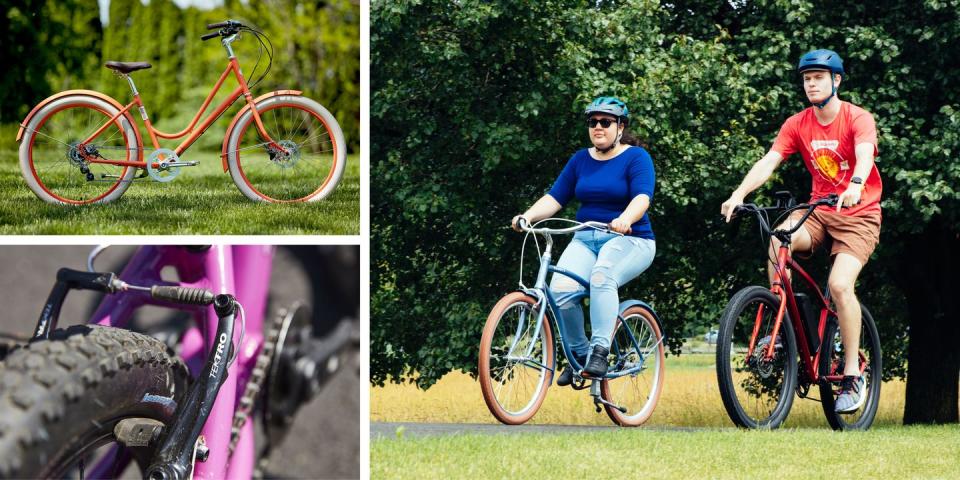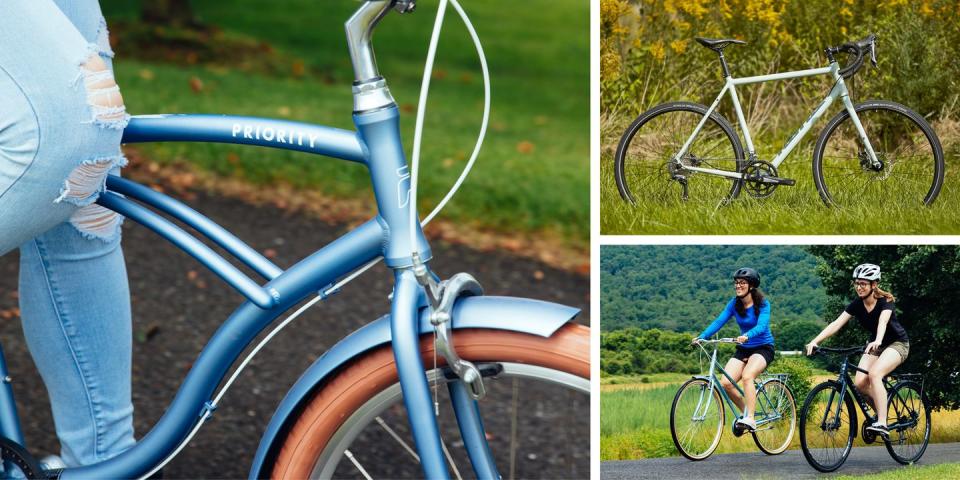The Best Beginner Bikes to Start Riding Now

Jumping on a new bike and pedaling down a bike path, on dirt trails, or exploring the alleys and side streets of your town is a healthy, stress-relieving way to add some fitness to your routine and escape Covid-related cabin fever.
That is, if you can find a bike. Manufacturing delays have many bike shops and online retailers without many models to sell. We’ve been testing beginner bikes all year, but some of the top performers are currently unavailable or have waiting lists to purchase. We still recommend those models, but if you need something quickly (and we completely understand that desire to ride), we’ve put together a list of bikes from manufacturers and retailers we trust below; we’ll try to keep this list of currently available models up to date.
No matter which bike you choose, be sure to read our buying guide below, which has lots of tips and advice to help you find the right model. Then read our longer reviews of top models. If you can wait several weeks (or longer, for some models), the bikes we tested are options we know to be reliable performers.
Best City Bike: Co-op City 1.1
Best Kids Mountain Bike: Co-op Rev 20
Best Balance Bike: Strider Classic
Best Women’s Hybrid: Cannondale Quick CX 3
Best Men’s Hybrid: Cannondale Quick Disc 5
Best City Electric: Aventon Pace 350
Best Cruiser: Electra Lux 3i
Best Townie: Electra 7D
Best Folding: Brompton M6R
Which Type of Bike Is Right for You?
Beginner bikes are more affordable and better than ever. You can now buy a high-quality bike for less than $600 that is designed to be stable, simple, and comfortable to ride. That’s a bit pricier than something you may find at a big-box store, but spending the extra money is almost always worth it: You get pro assembly and parts that won’t rust, perform better, and will last years longer than lower-cost options. Check out our five favorites below and keep reading for other tested options and buying advice.
If you’re ready to buy your first bike, the number of options can be daunting. Start by asking yourself where you want to ride. How you answer that question will help determine the right type of bike.
If you’re planning to ride trails or unpaved paths, you might be most comfortable on a hardtail mountain bike. The knobby tires give you better traction in the dirt and the suspension fork will soak up some of the bumps in the trail. Basic options start at $700 to $800.
If you’re planning to stick to paved paths, sidewalks, and boardwalks, try a cruiser or hybrid bike. A cruiser bike is a classic-looking bike with a wide, sweeping handlebar that’s great at lower speeds and start at about $300 for models with just one speed. A hybrid bike is designed to be ridden for exercise or fun while still keeping the rider in a comfortable, upright position. Prices start at about $500.
For mostly paved-road riding, your fastest option is a road bike. Built with narrower tires and drop-style handlebars, a road bike is the fastest option for riding smooth surfaces. Look for models with an aluminum frame and (if you can afford it) disc brakes, which offer better control. Those details put the price about $900, but some cheaper options exist if you go with rim brakes. If you plan to ride mostly dirt and gravel roads, try a gravel bike. The wider, grippier tires will make your dirt or gravel road riding more comfortable when the pavement ends. Like with road bikes, prices start at about $900.

Do I Need an E-bike?
If you are looking for a bike for transportation or want some pedal-assisted exercise, e-bikes will get you to your destination with less effort (and less sweat) than a regular bike. While an e-bike still requires pedaling, the motor will boost your speed according to how hard you pedal (up to 20mph). In exchange for this assist, you’ll have to charge the battery every few days (or daily, depending on your battery’s range). Because of the added weight of the battery and motor, e-bikes are much heavier than regular bikes, so they’re harder to move and store. They’re also more expensive. The cheapest e-bikes still cost at least $1,000.
Key Features for Beginner Bikes
Stability: A stable bike will give you enough support from the bike as you balance and corner, allowing it to be predictable and maneuverable at slow speeds. A bike with good stability will have a longer wheel base, wider handlebars, and a low standover height so you can more easily put your foot down to steady yourself.
Relaxed positioning: You want to be comfortable on your bike—the more happy and relaxed you are, the more you’ll ride. Most beginner bikes keep the rider’s back somewhere between a 90- and 70-degree angle with the ground, to put less strain on your back and neck.
Wider tires: No matter what type of bike you purchase, look for options with wider-than-typical tires. They offer more grip and traction, so you can ride more safely across most conditions.
Proper fit: Use this guide to get an idea of what size you need. Try to test ride the model you like if you can, or research the geometry and hop on something similar to get a sense of it.
How We Tested These Bikes
All of the bikes below have been ridden and evaluated by our team of test editors. To choose the right ones, we speak to the designers, engineers, and product managers who develop these bikes to understand the intended user, and the design goals. And we weigh that with our own research into the market and experience riding similar bikes.
To test these bikes, we asked several riders of different abilities and background to commute on them, ride them on a stretch of our local rail trail, and run errands. For e-bikes, we ran the batteries down to see how long they’d last on a single charge. And we took the mountain bikes on a mild (but still challenging) test loop in Eastern Pa. Basically we rode them the same way you would in order to get an accurate sense of how the bikes would meet your needs.
To make our recommendations, we weighed cost, performance, style, ease of maintenance, and our long-term experience with similar bikes. For those you can order online, we also considered the quality of the initial build and how much effort (or cost) you should expect to assemble the bike.
—BEST RIGID KIDS' MOUNTAIN BIKE BIKE—
Co-op Rev 20
With its disc brakes, extra-wide tires (called “Plus-size”) and reliable Shimano shifting, this bike gives young trail riders a lot for the price. Our 8-year-old tester immediately hit the trails, where the 2.6-inch tires, run at low pressure, helped the bike roll over rocks, ruts, and small logs across the singletrack. At about 24-pounds, it’s heavier than some rigid 20-inch bikes, but the extra traction and cushion from the wheels make it a reasonable tradeoff; the plus size tires offer some of the benefits of a suspension fork, which can add weight (or hundreds of dollars) to the price of a kids’ bike. Co-Op is REI’s house brand and the retailer delivers the bikes mostly assembled or allows you to pick them up in the store. They toss in a nice Park multi-tool, but unless you have decent bike-mechanic skills, we suggest in-store pickup if that’s an option. The test bikes we received required more brake and derailleur adjustments than those from other consumer-direct brands.
—BEST CRUISER BIKE—
Priority Coast
The salt air is no match for the Coast’s rustproof components, which include stainless-steel spokes, an aluminum frame and fork, and a maintenance-free Gates Carbon Drive belt. Sealed bearings keep out water, and Kenda puncture-resistant tires are hardly fazed by broken glass and clamshells. On boardwalks and level city roads, you’ll likely spend most of your time in the hardest gear, but you’ll be thankful for easier pedaling when the street takes a slight upturn. A double kickstand keeps the bike from tipping when parked, and the traditional cruiser-style handlebar has a three-speed twist shifter on the right and a front hand brake on the left (though you have the option of using the coaster brake).
READ FULL REVIEW MORE IMAGES
—BEST GRAVEL BIKE—
Kona Rove
Though noticeably heavy for a road or gravel bike 26.8 lb. (58cm), it doesn’t feel like a heavy bike when you’re riding it. The aluminum frame and wheels are strong and efficient, even uphill. On patches of sharp, barely-crushed stone and drifts of washed out sand, the Rove maintains a steady composure, keeping the rider balanced and in control. The wide, puncture-resistant tires cruise over pointy, golf ball-sized rocks and track easily through soft lumps of dirt.
—BEST WOMEN’S HYBRID BIKE—
Specialized Alibi C Step-Through
Flats can ruin a ride and discourage you from getting back on your bike. Specialized is solving those problems by using solid Nimbus Airless tires. While some solid tires feel harsh and lifeless, these are better. The aluminum frame is lively and the bike itself is surprisingly light and perky to ride. A mini suspension seatpost delivers about 20mm of travel and the fork is shaped and angled to take the edge off bumps and decrease road chatter. The Alibi has a 42-tooth chainring on the Shimano Tourney 7-speed drivetrain and the 14-34 cassette means you can zip along on the flats and still spin comfortably when the ground tilts up. The step-through frame makes it easy to hop on in jeans or a dress, and rack and fender mounts let you turn it into an all-weather errand runner.

—BEST MEN’S HYBRID BIKE—
Specialized Sirrus X 4.0
If you’re searching for a bike that is as fun to ride as it is utilitarian, consider the Specialized Sirrus X 4.0. The 38mm-wide Pathfinder Sport tires have knobby sides for cornering and a flat strip down the middle for rolling fast on pavement. The carbon fork, wide tires, and handlebar suspension smooth out the ride. A wide gear range plus rack and fender mounts mean you can haul your stuff even where it’s hilly. It’s fast and maneuverable, making it ideal for quick city commutes and efficient errand running. To expand its capabilities, Specialized added 38mm gravel tires and its Future Shock, a rubber-encased coil shock above the headset with 20mm of travel to help absorb any front-tire impacts. These additions, plus the carbon fork, help it smooth out your ride on any road.
—BEST WOMEN’S ROAD BIKE—
Liv Avail 1
Whether you’re a dirt shredder looking to throw down on some pavement or you’re ready to try your first fondo or bike tour, the Avail 1 is an accessible entry-level endurance bike ideal for women looking to get into the road-riding scene. The aluminum frame and geometry put the rider in a more relaxed position than a race bike, which offers a comfortable ride (and makes soaking in the scenery a bit easier on your neck). While the 9-speed Shimano Sora shifting system does add a good bit of weight to the bike, it’s sturdy and reliable, and the oversize headset bearings and tapered steerer tube create a stiffer front end for more responsive maneuvering.
—BEST MEN’S ROAD BIKE—
Giant Contend 3
This bike’s 16-speed Shimano Claris groupset, Tektro rim brakes, and aluminum fork setup is plenty capable for a lot of riders, even those who may think their ability level is beyond this bike. The frame is on par with other aluminum road bikes that are twice its price. The geometry places you in a relatively upright position, which made riding near tempo and spinning uphill feel less taxing than when on racier models, and it felt surprisingly compliant when riding over 20 mph.
—BEST MEN’S MOUNTAIN BIKE—
Rocky Mountain Growler 20
The Growler 20 is one of the best-value mountain bikes we’ve tested. In fact, it’s one of the few models you can buy for less than $1,000 that is built to ride challenging trails. We’d have no problems taking this on our local rides or even backcountry adventures. It’s not flashy, or extra light, or super fast, but it is an aluminum hardtail with a 120mm-travel Suntour fork, 27.5 x 2.8-inch WTB Ranger tires, and a 1x9 Shimano drivetrain that far outperforms its price. That’s largely due to its trail-oriented geometry, which is rare to find on models in this price range.
—BEST WOMEN’S MOUNTAIN BIKE—
Scott Contessa Active 50
This hardtail from Scott is the perfect gateway bike for those just beginning to venture off-road. Though the 100mm Suntour fork has enough travel to keep you riding comfortably on most smooth trails, the suspension does have its innate downsides; the cost of a cushioned ride is the loss of energy you’ll experience when pedaling up an incline. The saddle on this bike is decent, but if you plan on spending more time sitting than standing, consider upgrading to something more adept at supporting your sit bones against bumpy terrain. The 8-speed Shimano Tourney cassette and triple chainring offered enough gears for spinning gently uphill, and the Tektro hydraulic disc brakes bring you to a full stop without any jerky movements. The rubber grips on the handlebar are super cushy and impressively tacky—even when your hands are sweaty. We also loved that the wide handlebar afforded a greater feeling of control over the entire bike. It’ll be hard to find so much quality—and fun—in another ride at this price.
—BEST E-BIKE—
Aventon Pace 350
If you’ve been an electric-bike window shopper all these years, now is the time to step inside and consider a purchase. The Aventon Pace 350 has made it easier (as in more affordable) to stop wishing and start riding. For a thousand bucks you get a Class 2 e-bike (that means it tops out at 20 mph and has a throttle), a 7-speed Shimano Tourney drivetrain, and five levels of e-assist. Aventon claims you’ll get about 30 miles on one charge depending on how you’re using your Pace 350. (As with any e-bike, when you factor in hills, wind, assist mode, rider weight, and all that fun stuff, range can be less.)
—BEST COMMUTER BIKE—
Marin Presidio 1
At $650, the Presidio 1 represents Marin’s idea of the baseline for meeting the urban cyclist’s needs. The Shimano Nexus 3-speed internally gear hub is smooth and much lower-maintenance than a similarly priced external drivetrain. The Vee Tire Co. Baldy tires are puncture-resistant and have reflective sidewalls for visibility, and the Shimano hydraulic disc brakes dispatch real stopping power. In other words, it does everything you need for safe, reliable urban commuting. But the Presidio 1’s party piece is apparent when it injects some adrenaline into your daily jaunt. Its roots are in the fitness-oriented Fairfax line, but the Presidio’s tall head tube and heads-up riding position make your steering input more immediate. It feels zippy under pedaling as you hop between bike lanes, and the 3-speed drivetrain shifts fast and suits all but the hilliest routes.
—BEST JUNIOR CROSS BIKE—
GIANT TXC ESPOIR
Designed for young cyclocross racers, this bike also works great as a gravel bike, or for any young riders who want to explore on paved and dirt roads. The lightweight aluminum frame keeps it nimble, and the low-standover height makes it easier to get on and off the bike (and control it once you’re riding). The 35mm tires come on 26-inch rims and mechanical disc brakes add stopping power over rim options. The aluminum frame, rims, hubs, and cranks helps keep weight down, without driving up cost. It’s a versatile, fun-to-ride machine that will make almost any kid feel invincible, whether they’re on the road or on a cross course.
You Might Also Like

